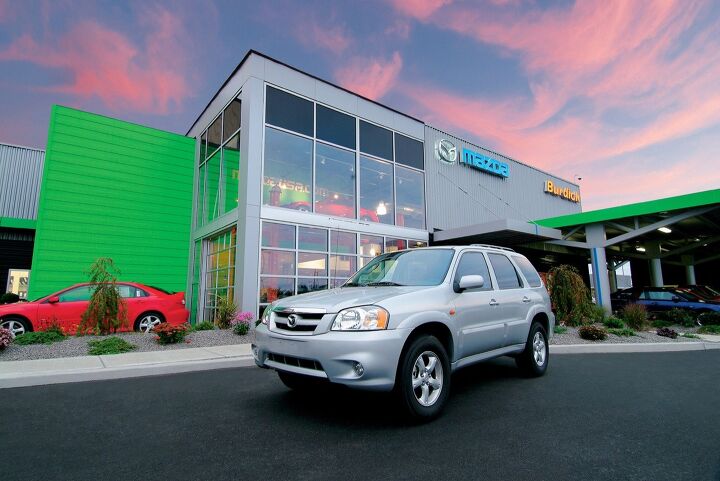Mazda Plans U.S. Dealer Network Makeover, Still Wants 2-percent Market Share (and More CX-5s)
“We have been working more closely with our dealers to evolve their businesses and through that process,” Mazda tells Automotive News, “some new dealers have chosen to begin working with us, while others have made the decision to leave the Mazda brand.”
Mazda has been open about its goal of earning 2 percent of the U.S. market while being forthright about the brand’s intentions to do so only on solid ground. This means fewer discounts, a premium vibe, and the kind of higher margins that make dealers happy.
On the dealer side of the equation, Mazda now wants those dealers to improve. In some cases, that means a new location. In others, a new exterior design is necessary. More thoroughly trained staff members is key, as well. But it’ll be slow going. Of Mazda’s roughly 600 dealers, the brand acknowledges that some have forsaken the automaker, though Mazda won’t say how many. Since the efforts to revamp dealers began last year, only 26 have been upgraded so far. By the end of the decade, Mazda believes roughly one-sixth of its network will have undergone a remodel.
In the meantime, Mazda is getting further away from reaching its 2-percent goal.
This isn’t a big surprise to Mazda. Masahiro Moro, Mazda’s North American CEO, thinks it could take a decade to thoroughly overhaul the brand in the United States, though the 2-percent market share tally could be achieved before 2026.
Yet it can’t be encouraging for a brand with market share goals to see market share stagnating one year after the brand’s 2016 market share fell to a 10-year low. With American auto sales falling 3 percent through the first eight months of 2017, Mazda’s share is steady at 1.71 percent, right on par with the 1.71 percent Mazda achieved during the first eight months of 2016.
Mazda, like every other automaker, could sell more vehicles. You can always sell more if you set the price low enough. But according to company spokesperson Yukari Hara, “We are taking on the challenge of prioritizing brand over sales.” Of course, it helps to have the right products to sell. While the Mazda MX-5 Miata, 6, CX-3, and CX-9 earn enthusiast press plaudits for exceptional enthusiast-oriented on-road behavior, seven out of every 10 U.S. Mazda sales come from the compact 3 sedan and CX-5 crossover.
The Mazda 3 is competing in a shrinking category, one that’s controlled by the Honda Civic and Toyota Corolla. In fact, eight compact cars sell more often than the 3, sales of which are down 19 percent this year in a segment that’s down 5 percent. It will be another two years before Mazda’s compression ignition engines transform the Mazda 3 — theoretically — into a fuel miser.
That means the CX-5, already the company’s best-selling U.S. model by a long shot, will be largely responsible for taking Mazda from 1.7 percent market share to a good 2 percent market share. Mazda executives told Automotive News that production of the CX-5 at the brand’s Hofu, Japan, assembly plant will be increased in order to increase U.S. inventory.
“We are progressing well with our planned shift to crossover models. We will ramp up production considerably in the second half,” Mazda’s Tetsuyo Fujimoto says. The CX-3, CX-5, and CX-9 already account for 55 percent of the brand’s U.S. volume.
[Images: Mazda]
Timothy Cain is a contributing analyst at The Truth About Cars and Autofocus.ca and the founder and former editor of GoodCarBadCar.net. Follow on Twitter @timcaincars and Instagram.
More by Timothy Cain
Latest Car Reviews
Read moreLatest Product Reviews
Read moreRecent Comments
- Lou_BC Well, I'd be impressed if this was in a ZR2. LOL
- Lou_BC This is my shocked face 😲 Hope formatting doesn't fook this up LOL
- Lou_BC Junior? Would that be a Beta Romeo?
- Lou_BC Gotta fix that formatting problem. What a pile of bullsh!t. Are longer posts costing TTAC money? FOOK
- Lou_BC 1.Honda: 6,334,825 vehicles potentially affected2.Ford: 6,152,6143.Kia America: 3,110,4474.Chrysler: 2,732,3985.General Motors: 2,021,0336.Nissan North America: 1,804,4437.Mercedes-Benz USA: 478,1738.Volkswagen Group of America: 453,7639.BMW of North America: 340,24910.Daimler Trucks North America: 261,959




































Comments
Join the conversation
I guess Mazda does know majority of their dealers look like buy hear pay hear lots.
We have 3 Mazda dealers in KC, to my knowledge, and 2 for sure are within 15min from my house. One is